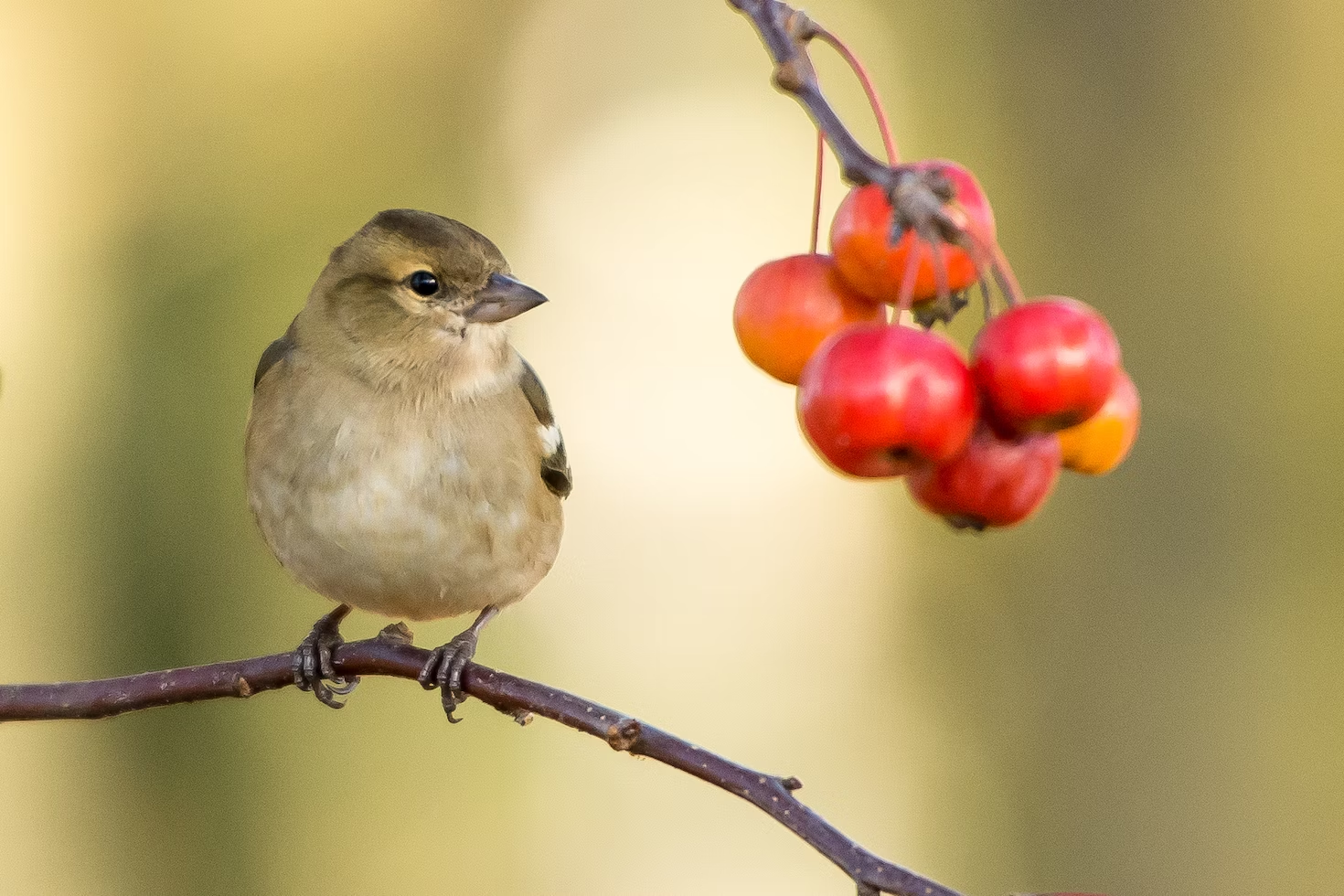As you peer out of your window, you might spot a vibrant dance taking place — beautiful creatures soaring and fluttering about with grace.
But birds serve more purposes than amusing us with their cheerful voices and colors. They also contribute to the environment in ways we hardly notice.
Some species act as efficient pest controllers, feasting on pesky insects. Others play a crucial role in pollination or fruit distribution.
In the following paragraphs, we’ll introduce you to 10 beneficial birds you’ll want to have around your backyard. We’ll also share helpful tips on how to attract these winged wonders.
Sit back and prepare for an enchanting journey into the world of our feathered friends.
1. Chickadees
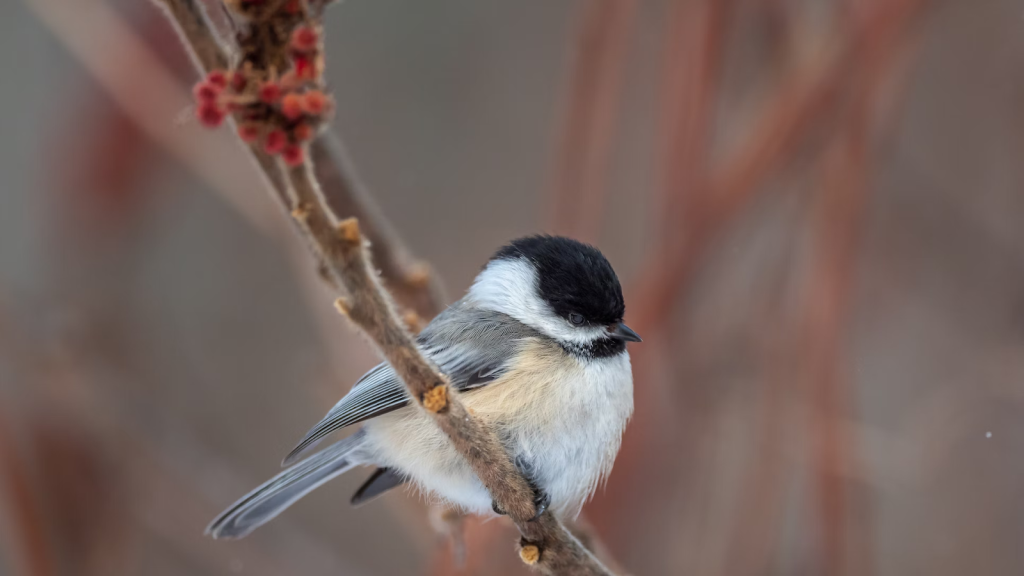
In the silent solace of nature, a musical harmony emerges — the enchanting chatter of chickadees.
These tiny, feathered aviators are the unsung heroes of the yards. With their unmistakable “chick-a-dee-dee” call, they add life and cheer to serene landscapes.
It’s not only their infectious, high-pitched song that makes chickadees endearing — it’s also the captivating black cap and bib that contrast with their white cheeks like a living yin-yang symbol. Seemingly stroked by an artist’s brush, these little acrobats’ soft, gray wings and underparts arouse awe in those who behold them.
But there’s more to chickadees than just their adorable appearance. As social creatures, they thrive on interaction.
Gathering in small, diverse flocks during winter months, these birds form intricate hierarchies that foster cooperation while ensuring survival.
These tight-knit communities form bonds so strong that even researchers can recognize individual chickadee “friendships.”
Chickadees are known to eat various insects, including caterpillars and aphids — a gardener’s natural method of pest control. They particularly favor protein-rich insects during the breeding season, which is when you’ll need those extra bug busters roaming around your garden.
Here’s a list of insects chickadees would be more than pleased to remove from your garden:
- Aphids
- Beetles
- Caterpillars
- Leafhoppers
- Moths
- Scale insects
- Snails
- Spiders
- Wasps
To attract chickadees to your yard, set up birdhouses for shelter and nesting. Introduce native trees or shrubs that provide both food and cover for these friendly flyers. Offering sunflower seeds and suet in feeders will also keep them coming back for more.
What chickadees look like: Adults have white cheeks and a solid cap on their heads. Their back colors vary from gray to black, chestnut, or brown. Their breast colors can be cream, white, chestnut, brown, or gray.
Where chickadees live in the USA: Found all across the United States, including Alaska, chickadees are a common sight in nearly every state. Their wide distribution means you’re likely to spot one in your backyard or local park.
2. Swallows
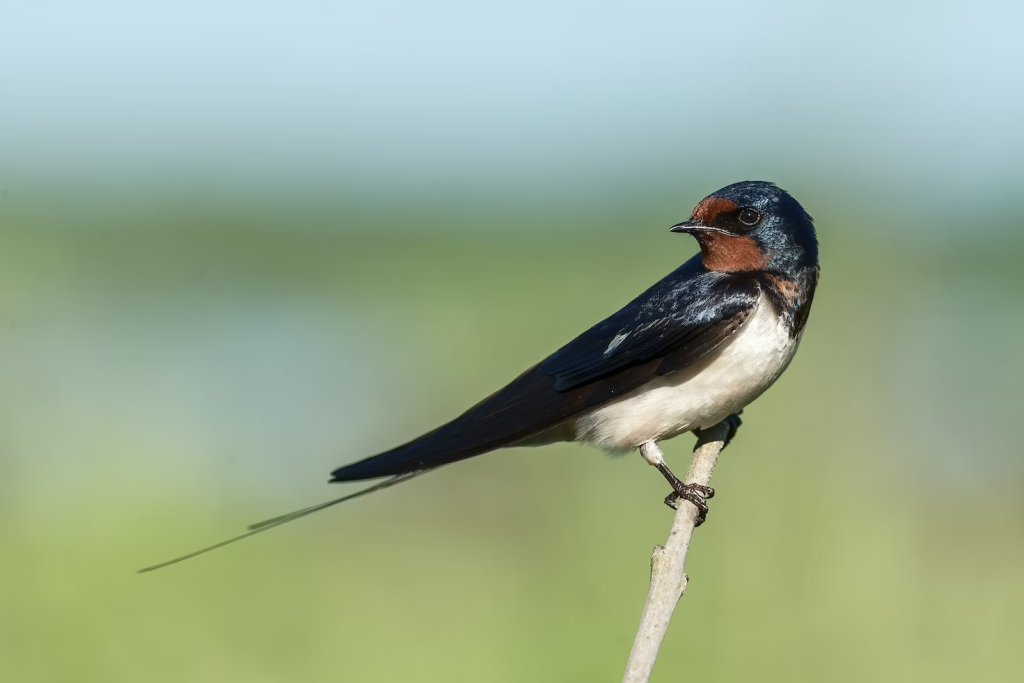
As the warm breeze of spring touches the earth, heralding the start of a new season, it brings with it a fascinating spectacle — the arrival of swallows. These small, graceful birds are known for their agility and aerial acrobatics, enchanting us with their seemingly effortless flight.
With a swoop and a glide, swallows carve their place in the sky. Yet, there’s more to these charming creatures than meets the eye.
Breathless beauty takes wing as swallows slice the air, their slender bodies often embellished with vibrant shades of cobalt blue or glossy black. Easily recognized by their long and deeply forked tails, these birds paint a stunning tableau against the backdrop of a clear sky.
Laying claim to unmatched mid-air agility, swallows twist and turn in pursuit of insect prey. These skilled hunters rely on their nimble wings to zero in on rapidly moving targets.
An unsuspecting mosquito is no match for the split-second reflexes of a swooping swallow.
Swallows’ diet comprises everything from flies to beetles. A list of bugs they love to snack on includes the following:
- Bees
- Beetles
- Damselflies
- Dragonflies
- Caterpillars
- Flies
- Grasshoppers
- Moths
- Stoneflies
- Wasps
Swallows are attracted to wide-open spaces, so make sure your yard provides ample airspace for swooping and diving. Consider installing nesting boxes specifically designed for these birds, as they prefer to build their nests in dark, secluded areas like barns or eaves.
What swallows look like: Swallows are unique birds that come in various colors and appearances. Some have a plain brown look, while others dazzle with iridescent blues and greens on their backs and crowns. There’s even a selection of species sporting orange-colored back or breast feathers.
Where swallows live in the USA: In the United States, swallows can be spotted across the lower 48 states and Alaska. However, their presence is usually limited to breeding or migration periods. Surprisingly, only a handful of these birds call the U.S. their full-time home.
3. Bluebirds
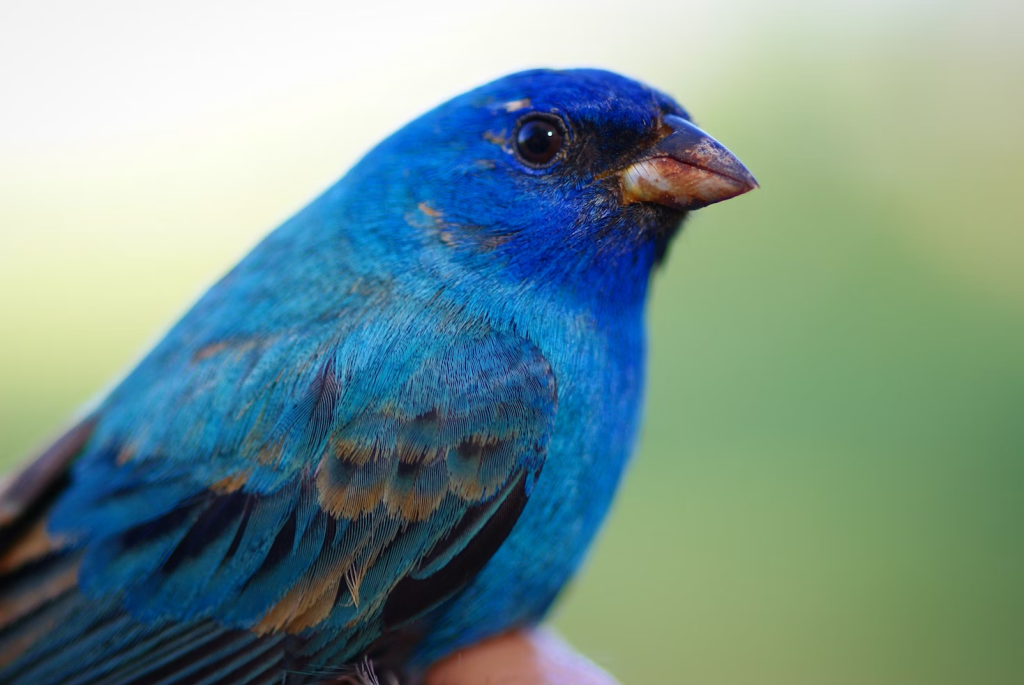
Ah, the enchanting bluebird. Perched gracefully on a blooming branch, it lends a touch of storybook charm to our daily lives. Its dazzling feathers shimmer like sapphires in the sunlight, catching our attention and capturing our hearts.
Aside from their stunning plumage, bluebirds are also champions at keeping your yard insect-free. They eat grasshoppers, beetles, and other insects that can cause damage to crops or plants.
Here are the main elements of their diet:
- Ants
- Bees
- Beetles
- Caterpillars
- Crickets
- Earthworms
- Grasshoppers
- Spiders
- Snails
In addition to pest control, bluebirds help with pollination since they feed on various berries from native plants.
The term “bluebird” may evoke images of a single species fluttering around your garden; however, there are actually three varieties that can grace your backyard:
- the Eastern Bluebird,
- Western Bluebird,
- and Mountain Bluebird.
Encourage bluebirds to visit by providing nesting boxes, preferably facing east, away from prevailing winds and predators. Maintaining a pesticide-free garden will give these beautiful birds a safe, ample food supply.
What bluebirds look like: From the crown of their head to the tip of their tail, bluebirds boast a beautiful blue hue. But that’s not all — the Eastern and Western Bluebirds also flaunt a striking red breast. On the other hand, the Mountain Bluebird has a more subtle color: a lighter shade of blue adorning its chest.
Where bluebirds live in the USA: These fascinating creatures can be found across the United States. Making their home in most areas of the lower 48 and Alaska, bluebirds either reside there year-round or choose to breed there.
4. Hummingbirds
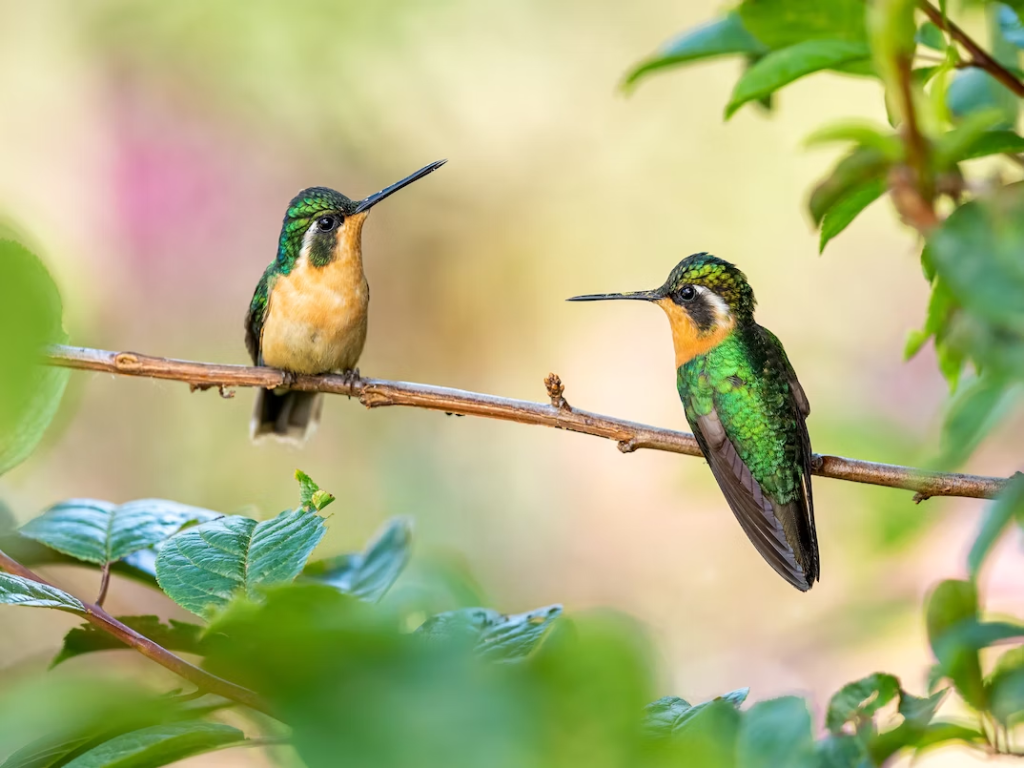
With a buzz and a blur, they zip through our gardens like mini superheroes; hummingbirds hold a special place in the hearts of bird enthusiasts around the world. Agile and mesmerizing, these aerial acrobats possess a unique grace all their own.
As they dazzle in the sunlight, hummingbirds play an essential role in pollination. These tiny wonders fly from flower to flower, sipping nectar and spreading pollen. It contributes to the growth of various plants and creates a healthy ecosystem within your backyard.
Voracious sugar-fiends, hummingbirds satisfy their energy demands with nectar up to 2,000 times a day! They’re not picky eaters either — they happily snack on insects, small spiders, and even tree sap, tapping into the natural world’s sweetest treats to fuel their rapid-fire wingbeats.
These tiny dynamos are found exclusively in the Americas, boasting a dazzling array of over 300 species with shimmering, iridescent plumage. It’s hard not to be hypnotized by their vibrant colors and breakneck speeds.
Planting a variety of bright-colored tubular flowers is a surefire way to attract hummingbirds. For best results, opt for trumpet vine, salvia, or fuchsia.
You can also hang hummingbird feeders filled with sugar water to give them additional food sources.
What hummingbirds look like: From the top of their tiny heads to the ends of their delicate tails, hummingbirds display a dazzling array of hues. It’s not just their iridescent greens and blues that catch our attention — species like the Ruby-Throated Hummingbird showcase a stunning red throat, while the Black-Chinned Hummingbird adorns itself with a hint of violet near the neck.
Where hummingbirds live in the USA: These creatures have made their homes in diverse regions across the United States. From parts of Alaska right down to Southern Texas, hummingbirds can be found residing or breeding in various habitats.
5. American Robins

Nothing says spring like the cheerful song of the American robin awakening you each morning.
Perky and adaptable, these energetic songbirds have captured the hearts of millions. Their unique combination of slate-gray plumage with a bold orange-red breast is what sets American Robins apart from the rest.
These familiar birds consume grubs, snails, and earthworms. They’re an ideal addition to your garden’s natural pest control system. Robins’ preference for fruit-bearing plants also makes them important seed distributors.
To attract robins to your yard, provide a water source such as a birdbath or shallow fountain.
At the same time, planting berry-producing plants like dogwood or juniper will provide food for them and encourage their beneficial seed-dispersing habits.
What American robins look like: American robins flaunt a vibrant ensemble of colors and patterns. These birds possess a warm reddish-orange breast contrasted with a grayish-brown body. Their heads feature a deeper shade of gray to near-black on their crowns. And they sport a distinctive white eye ring, giving them an added touch of charm.
Where American robins live in the USA: Spread across the diverse landscapes of the USA, American robins prefer to dwell in gardens, parks, woodlands, or open grassy areas. You’ll find them from Alaska all the way down to Central America, making their broad-stretching presence unmistakable.
6. Goldfinches

Bursts of vibrant yellow, brilliant red, and striking black greet the eyes as nimble goldfinches dance through the air. These avian gems bring a touch of magic to gardens and woodlands across the globe.
Don’t let their petite stature fool you; goldfinches are powerhouses of energy, practically radiating joie de vivre as they flit from tree to tree.
A delightful juxtaposition between dazzling appearance and humble charm, these winged wonders delight in simple pleasures — like nibbling on thistle seeds or chattering animatedly with their flock. Their appetite for seeds ensures that weed populations remain under control, keeping your garden tidy without any extra effort from you.
Goldfinches are also known to occasionally feed on insects during the breeding season, supporting your garden’s pest control system.
As these lovely fliers are social by nature, you can often see them in groups, covering substantial areas and benefiting larger portions of the landscape.
Attracting goldfinches to your yard is relatively easy. All you have to do is set up tube feeders or mesh sock feeders filled with their favorite food — Nyjer seeds. Keep an abundant water supply available with birdbaths or shallow fountains to encourage their visits.
Planting seed-producing native wildflowers such as coneflowers, sunflowers, and asters will also show goldfinches that your garden is their dining paradise.
What goldfinches look like: Goldfinches boast an array of stunning feathers. Their colors include yellow, black, gray, and white. With three species, the color patterns vary widely. It’s interesting to note that some juveniles differ in appearance from their adult counterparts.
Where goldfinches live in the USA: In the United States, the American Goldfinch has a vast range. They can be spotted throughout all the lower 48 states during parts of the year.
Meanwhile, their cousins, the Lesser Goldfinch, prefer the Southwest as their home.
Lawrence’s Goldfinch is a bit more selective. They are found in specific climates in California and occasionally in southwest Arizona.
7. Nuthatches

Described as “upside-down birds” due to their peculiar habit of scaling tree trunks and branches headfirst, nuthatches are distinctly unique in their own right.
Sporting slim yet sturdy bodies and sharp beaks that suit their dynamic lifestyle, nuthatches can be found flitting in and out of forests across the Northern Hemisphere.
Their diminutive size — ranging from about 3.5 inches for Pygmy Nuthatches to around 6 inches for the more robust White-breasted species — belies their big personalities and extraordinary tree-climbing abilities.
Dressed in stunning shades of blue-gray, rusty-red or chestnut-brown, these tiny wonders have a knack for captivating onlookers. Combine that with their energetic nature, and nuthatches weave a fascinating tale of avian splendor.
But don’t let their charming demeanor fool you. Beneath their seemingly delicate exteriors lies the steely nature of survivalists.
These acrobatic birds primarily feed on insects such as beetles, ants, and caterpillars, adding to their pest control prowess. They also help with seed dispersal since they consume seeds from trees like pine, spruce, and fir.
To entice nuthatches into your yard, provide nesting boxes tailored for their size and preferences. Making your garden home to mature trees will offer plenty of foraging opportunities for these agile climbers. To supplement their diet, you can also offer black oil sunflower seeds or peanuts in bird feeders.
What nuthatches look like: Nuthatches’ appearances can vary greatly depending on the species. Some nuthatches have brown crowns on their heads. Others have a mix of brownish-gray or black with a white band around the eye area. Their throats can be white or chestnut in color. The backs of these birds generally have gray-blue and black shades.
Where nuthatches live in the USA: If you live in the United States, there’s a good chance you’ve seen a nuthatch. They can be found in different parts of the country throughout most of the year. The White-breasted Nuthatch is particularly widespread and can be spotted in all of the lower 48 states.
For those living further north, keep an eye out for the Red-breasted Nuthatch. This species extends its range up to southern Alaska.
8. Owls
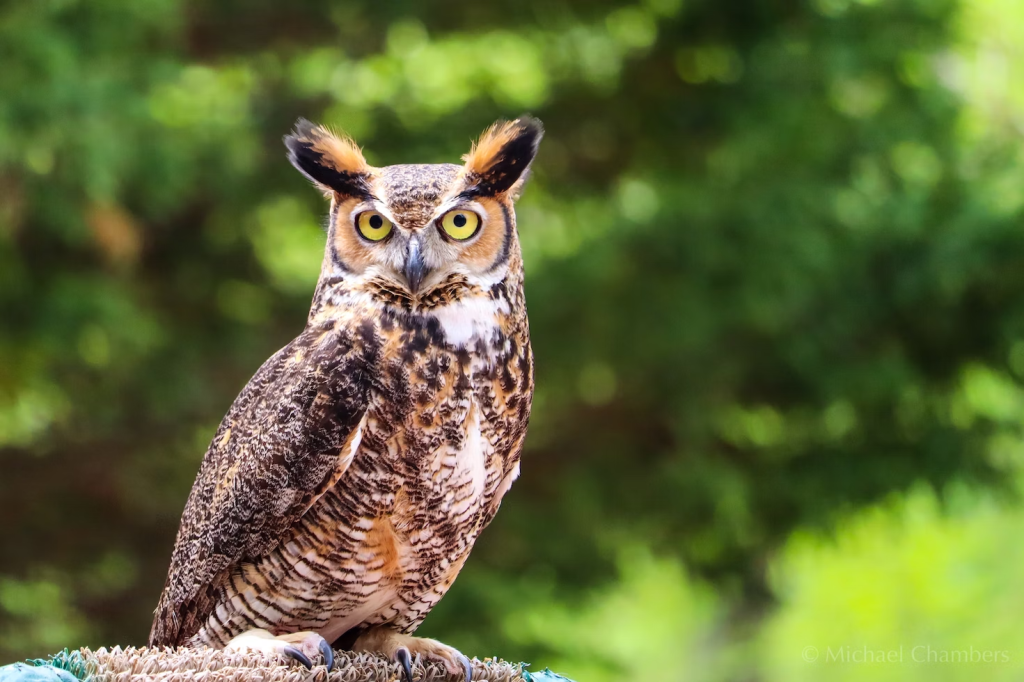
Covert and captivating, owls have been revered by ancient civilizations and inspired myths for centuries.
Nighttime guardians of your yard, these majestic birds might seem elusive and mysterious, but their value as pest control should not be underestimated.
Renowned for their excellent rodent-catching skills, owls consume rats, mice, voles, and gophers — an incredible asset to have around your home or garden.
Their appetite for rodents makes them beneficial for controlling the spread of diseases associated with these small critters.
With over 200 species adorning our planet, owls wear coats of mesmerizing patterns, donning plumage that dances between shades of tawny browns, earthy grays, and pure white.
Creating suitable roosting and nesting spots is essential to attract these nocturnal creatures to your property. Consider installing owl boxes or encouraging the growth of old trees with cavities suitable for their nests.
Owls are also keen hunters in fields and meadows, so if space permits, let part of your yard grow wild with tall grasses and wildflowers to support their hunting grounds.
Minimize the use of rodenticides and pesticides to ensure a safe environment for these nocturnal birds. Keep outdoor lighting to a minimum as well since too much artificial light can disrupt owls’ hunting patterns and interfere with their overall well-being.
What owls look like: Owls’ feather colors and patterns differ. Heights, wingspans, and weights vary too. Still, some features are universal. All owls have circular heads and flattened or concave faces that give way to front-facing eyes and a hooked, abbreviated beak.
Where owls live in the USA: In the United States, owls make their homes in various locations. They inhabit all of the lower 48 states. Alaska is also home to these remarkable creatures.
9. Wrens
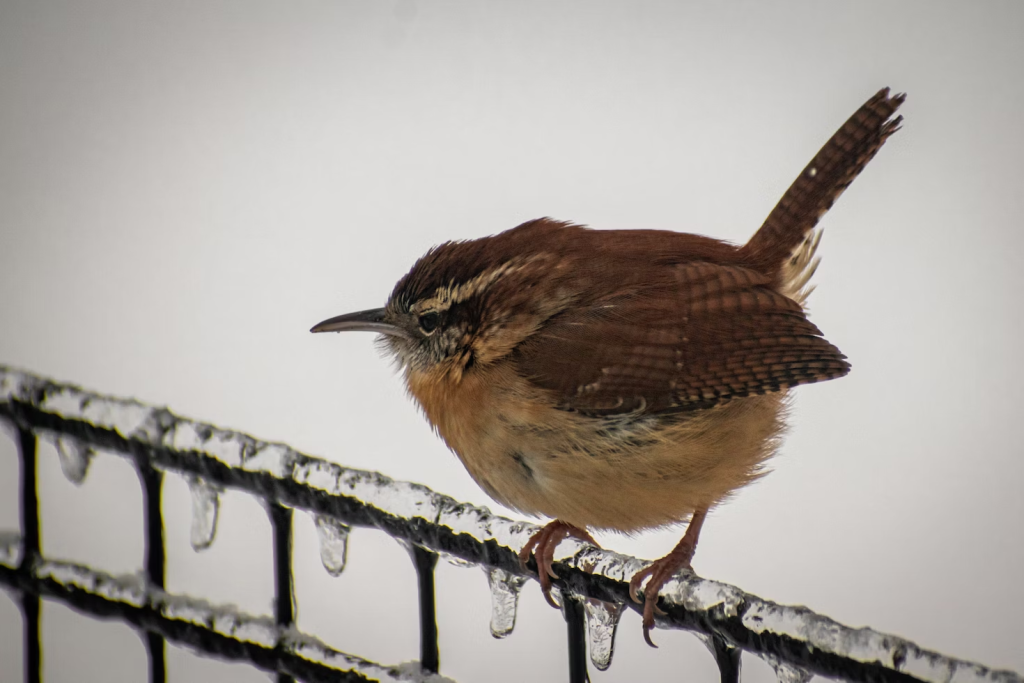
Wrens may be small in size, but they have a giant impact on your garden’s health. These energetic and charismatic birds are known for their remarkable appetite for insects, including ants, caterpillars, spiders, and beetles.
Many wren species consume ticks as well, making them valuable partners in reducing the risk of tick-borne diseases.
The list below includes some of their favorite foods:
- Ants
- Beetles
- Caterpillars
- Crickets
- Flies
- Grasshoppers
- Leafhoppers
- Moths
- Snails
- Spiders
- Wasps
Attracting wrens to your yard is as simple as providing them with the proper nesting and feeding environment.
To create a wren-friendly habitat, set up a nesting box or birdhouse with a small entry hole to keep out larger birds and predators. Position these houses in a sheltered, shaded location close to shrubs or low-growing vegetation for extra security.
In addition to natural insect sources, offering suet or peanut butter in feeders will satisfy these insatiable insectivores.
To further entice wrens, plant native vegetation with dense foliage to provide additional cover. Including a water source such as a birdbath or shallow pond will make your yard attractive to these delightful birds.
What wrens look like: Wrens are tiny creatures with colors ranging from shades of brown and gray to tan and white. Their backs flaunt speckled patterns that add a touch of whimsy to their appearance. And let’s not forget their elongated, protruding beaks — a distinctive feature that sets them apart.
Where wrens live in the USA: As for the habitats of these charming birds, they can be seen flitting around in most parts of the United States. From the lower 48 states to the chilly lands of Alaska, wrens are known to wander throughout the year.
10. Woodpeckers

Don’t be alarmed by the characteristic ‘rat-a-tat-tat’ of woodpeckers. These fascinating creatures are doing more than drilling holes in trees — they play a crucial role in maintaining the health of your local ecosystem by keeping tree-dwelling insects, such as beetles and ants, under control.
Consequently, they prevent infestations that could damage your favorite shade provider.
Woodpecker activity can also create snags and cavities that become homes for other beneficial wildlife like owls, chickadees, and nuthatches. Even the unoccupied holes may serve as shelters for bats or flying squirrels, further enriching the biodiversity in your backyard.
Welcoming woodpeckers is as simple as preserving dead or decaying trees on your property whenever safety permits.
If you don’t have any deadwood available, consider installing specially designed nesting boxes for woodpeckers.
Finally, setting up suet feeders will supplement their diet during colder months when insects are scarce.
What woodpeckers look like: Woodpeckers boast an impressive appearance that easily attracts attention. These birds, often sporting vibrant colors such as red, black, and white, have strong, chisel-like beaks and stiff tails that support their bodies as they diligently peck away at tree trunks. Their striking plumage, combined with a unique head pattern and zygodactyl feet — two toes facing forward and two backward — helps them maintain a firm grasp while hammering into the wood.
Where woodpeckers live in the USA: In the diverse landscape of the United States, woodpeckers thrive in various habitats, ranging from dense forests to suburban backyards. Found in every state across the country, these persistent creatures adapt well to their surroundings.
How To Attract Beneficial Birds to My Yard?
Not many things are more heartwarming than a bustling garden filled with birds. Because of that, it’s worth putting in the effort to lure these winged wonders into your outdoor sanctuary.
Follow these tips to create an enticing space for a variety of beneficial bird species to call home.
Provide Food Sources
Bird feeders stocked with seeds, nuts, suet, and dried fruit will have your feathery friends swooning. Choose feeder designs that accommodate different bird species and deter squirrels.
Offer Safe Water Sources
A birdbath or water feature is not just a luxurious spa retreat for your feathery guests — it’s essential. After all, birds need water to drink and preen.
It doesn’t take much effort, either. For example, you can transform a simple saucer into a refreshing oasis by filling it with water. Keep the water clean by washing containers regularly. During winter months, consider adding a heating element to prevent freezing.
Plant Native Trees and Shrubs
Incorporate native greenery in your yard to provide natural shelter and nesting spots. Native plants also attract insects, which form a crucial part of many birds’ diets. Opt for fruiting plants like berry bushes that will serve as an additional food source.
Add Nesting Boxes
Nesting boxes offer extra spaces for birds to raise their broods while protecting them from predators. Choose boxes tailored to the specific species you wish to attract and mount them at varying heights suitable for their preferred nesting locations.
Create Natural Habitats
Recreate natural habitats by incorporating diverse layers of vegetation like ground covers, shrubs, and tall trees. Allow a portion of your yard to grow wild with native grasses and wildflowers to provide shelter and food for birds.
Offer Perching Spots
Birds appreciate perches that give them a vantage point to scan their surroundings or rest. Place birdhouses, feeders, and birdbaths near trees or install poles with crossbars in your yard for a bird-friendly environment.
Establish a Pesticide-Free Zone
Reduce or eliminate the use of pesticides in your yard. Chemicals can harm not only the insects that birds eat but also the birds themselves. Encourage natural pest control by attracting insectivorous birds instead.
Provide Food Year-Round
Keep bird feeders full during all seasons to offer a constant source of nutrition for your feathered friends. Adjust the type of food provided, as some bird species have different dietary needs throughout the year.
Keep Predators at Bay
Discourage cats and other predatory animals from visiting your yard by installing deterrents like motion-activated sprinklers. Secure feeders, birdbaths, and nesting boxes at heights harder to reach for predators.
Final Thoughts
From colorful hummingbirds to upside-down nuthatches, beneficial birds can enhance your backyard ecosystem’s natural beauty and health.
Inviting these cheerful creatures into your yard can be an enjoyable and rewarding experience. Not only do these winged allies nurture the environment with their natural pest control abilities and pollination skills, but they also bring unparalleled beauty and entertainment.
As you create a bird-friendly habitat, prepare to enjoy the many benefits they bring. The dynamic interactions between these creatures set the stage for hours of captivating entertainment, sure to delight all who witness them.
And as their presence nurtures the various elements within your small but vibrant ecosystem, you’ll marvel at just how much difference a few birds can make. Good luck!
Was it helpful?

Enamored with the world of golf Jack pursued a degree in Golf Course Management at THE Ohio State University. This career path allowed him to work on some of the highest profile golf courses in the country! Due to the pandemic, Jack began Inside The Yard as a side hustle that quickly became his main hustle. Since starting the company, Jack has relocated to a homestead in Central Arkansas where he and his wife raise cattle and two little girls.

